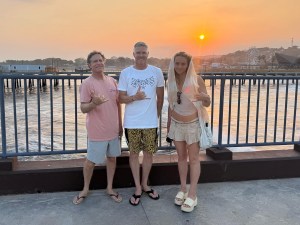By Mike Latronic – If there’s one place redefining what a surf trip should be, it’s El Salvador. With machine-like point breaks, warm water, and deeply rooted surf culture, this Central American jewel is firing on all cylinders. Whether chasing world titles or just chasing stoke, El Salvador is proving to be a top-tier destination for surfers of every stripe.

As you might’ve picked up from earlier in this mag, I recently traveled to El Salvador as a journalist and media producer to cover the world-class free surfing that went down during the waiting period for the Surf City El Salvador Pro at Punta Roca. This wasn’t just another contest—this was an elite performance paired with a perfect canvas for progressive surfing.
A few weeks later, the show shifted to El Sunzal for the ISA World Longboard Championship, and the vibe transformed. Where Punta Roca was raw octane, El Sunzal was timeless grace—long, playful rights that begged for style, poise, and technical nuance. Watching the world’s top longboarders carve these lines reminded me that surfing is an art, not just a sport.
But the real magic? That came during the final stretch of my trip. The pros flew out and the everyday rippers took over. I brought along two solid surfers from Southern California—Mike Estrada and Malia Ward—not to chase trophies, but to see what a surf mission here feels like for the rest of us normal earthlings. Let’s call it the Surf Trip 101 Experiment.
My basecamp was first at Papaya Surf Garden and next, Mira Surf. Both are lovely beachside hotelsl with access to several breaks, amazing local cuisine, and tropical charm. From there, we explored El Tunco’s lively cobbled streets, hit waves like La Bocana, Sunzal, and La Bocanita, and surfed every single day of our stay. It was, in a word, effortless.
Estrada captured it perfectly:
“The travel experience getting here was super easy. We took a direct flight from L.A., and boom—we’re in the zone. Everything’s right here: the food, the waves, the vibe. If you want to explore more, a short ride north or south gets you into another perfect setup. It’s shockingly convenient.”
And that’s no accident. The Surf City initiative—El Salvador’s national tourism revamp—has modernized infrastructure, improved roads, boosted beach safety, and poured fresh energy into surf culture. Nowhere is that more evident than in La Libertad, where smooth highways, Wi-Fi-ready cafés, boutique hotels, and friendly locals make surf travel seamless. The airport is just 45 minutes from the coast, and once you arrive, dozens of consistent points and beach breaks are yours to choose from.
“Most people don’t want to burn three days traveling just to score,” said Estrada. “With El Salvador, you get in, you settle, and you surf. Compared to other destinations I’ve been to, this ranks top three—easily. For consistency, access, good food, warm water, and friendly people… this place is firing.”
Consistency is key—and El Salvador delivers in spades.
“I’ve been in and out of El Salvador for the last two months and haven’t seen it drop below three feet,” I said to Malia one evening. “It gets two-to-four, four-to-six, six-to-eight, then dips back and cycles again. Even on the rare slow days, there’s always somewhere firing. If you want to surf daily, this is the place.”
Even when tropical rain rolls through overnight, mornings reset with glassy offshore winds and blue skies—a freakishly reliable pattern. As Malia put it:
“The first two days were a perfect warm-up—Sunzal, La Bocana—it’s just so fun here. Even when it’s small, there are still good waves, and the warm water just makes everything better.”
She added,
“Getting here was easier than going to Hawaiʻi. I hopped on a plane, watched a movie, listened to music, and suddenly we were descending. Five hours, direct flight—done.”
Ward, who’d visited El Salvador more than a decade earlier, recalled the contrast vividly:
“The first time I came, I wasn’t doing big turns yet, but I remember Punta Roca—it was thrilling. Back then, it was sketchy. Now? It’s night and day. The locals are kind, stores are open, the streets are safe. It feels like a mini-Bali with Central American aloha.”
Indeed, safety is one of the most notable changes in recent years. Once considered risky, El Salvador has undergone a transformation.
“Fifteen years ago, it had a completely different vibration,” said Estrada. “Now, it’s become one of the safest countries to travel in Latin America. You can feel it—locals are relaxed, welcoming, and genuinely stoked. It’s that aloha spirit—Central American style.”
Surf City truly caters to all: pro-level surfers dialing in contest boards, passionate travelers revisiting the dream, or first-timers chasing their best session yet. The breaks are real. The culture’s alive. And the welcome is warm. If you’re looking for your next surf mission, consider this your green light. Whether you’re aiming to push performance or simply reconnect with the joy of travel, El Salvador is ready. This isn’t just another stamp in your passport. This is Surf Trip 101. And class is most definitely in session.
Original Post from this site
